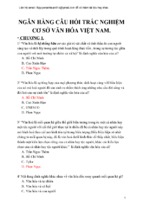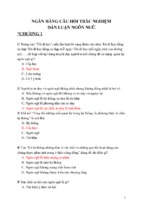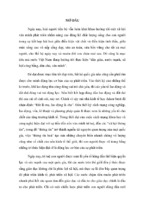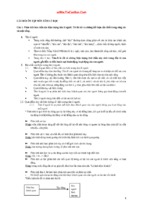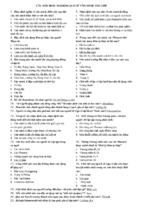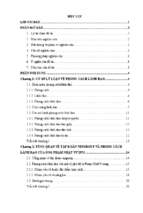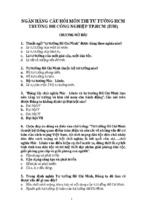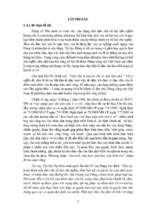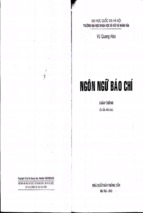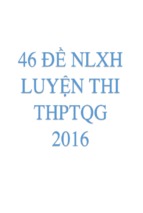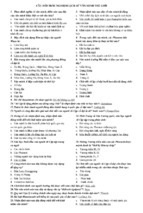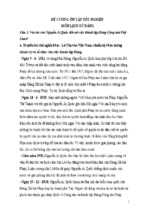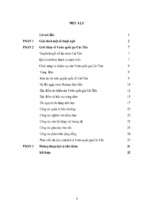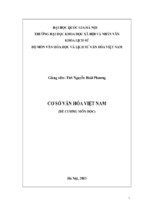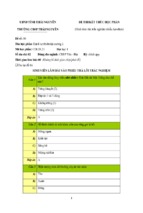MINISTRY OF EDUCATION
AND TRAINING
VIETNAM ACADEMY
OF SCIENCE AND TECHNOLOGY
GRADUATE UNIVERSITY SCIENCE AND TECHNOLOGY
…………***…………
VU THI THU LE
RESEARCH ON CHEMICAL CONSTITUENTS AND
BIOLOGICAL ACTIVITIES OF CALLICARPA CANDICANS AND
CALLICARPA MACROPHYLLA GROWING IN VIETNAM
Major: Chemistry of natural compounds
Code: 9.44.01.17
SUMMARY OF CHEMICAL DOCTORAL THESIS
HA NOI - 2020
This thesis was completed at Graduate University of Science and Technology
- Vietnam Academy of Science and Technology.
Supervisors:
1. Assoc.Prof. Dr. Pham Thi Hong Minh
Institute of Natural Products Chemistry – Vietnam Academy of Science
and Technology
2. Prof. Dr. Pham Quoc Long
Institute of Natural Products Chemistry – Vietnam Academy of Science
and Technology
Examiner 1: Assoc.Prof. Dr. Phan Minh Giang
University of Science – Vietnam National University
Examiner 2: Dr. Đỗ Hữu Nghị
Institute of Natural Products Chemistry – Vietnam Academy of
Science and Technology
The thesis defense was monitored by the Graduate University level Board
of Examiners, held at: Graduate University of Science and Technology - 18
Hoang Quoc Viet - Cau Giay - Ha Noi.
At ……….. , ….………………….. 2020
The thesis is available in Vietnam National Library and Library of Graduate
University of Science and Technology.
1
PREAMBLE
1.
The urgency of the thesis
Vietnam is located in a tropical climate region with extremely rich natural
resources and biodiversity with many valuable medicinal herbs. The increasing
use of traditional medicinal herbs or from naturally occurring compounds has
taken an important position in medicine. Herbal remedies are the subject for
scientists to fully study the nature of the active ingredients in natural plants, the
results of the study will contribute to a better explanation of the effects.
Treatment of traditional medicinal plants is still often used in folk.
In the world, studies of the genus Callicarpa mainly focus on: botanical,
pharmacology, plant chemistry and clinical. Pharmacological studies
conducted on crude extracts or pure compounds provide the scientific basis for
traditional use. Biological activity studies mainly focused on activities: antiinflammatory, hemostasis, memory loss, oxidation, antibacterial. Studies of
chemical composition and biological activity in the world show that
diterpenoid and triterpenoid compounds have very good anticancer activity,
which is the most abundant chemical component in Callicarpa genus.
The research to find out the active ingredients of plants has been receiving
the attention of scientists from many countries around the world, including
Vietnam. This is also the reason for the topic "Studying the chemical
composition and biological activity of the Sheic species (Callicarpa candicans)
and the large-leafed Tuzhou (Callicarpa macrophylla) in Vietnam." be selected
for research.
.
2. The research objectives of the thesis
Isolate and determine the chemical structure of compounds from C.
candicans and C. macrophylla species collected in Vietnam.
Assessment of toxic activity on some cancer cell lines: liver (Hep-G2), lung
(Lu-1) and breast (MCF-7) of isolated clean compounds.
Researching the chemical composition of C. candicans and C. macrophylla
essential oils.
3. The main research content of the thesis
1.Determining the chemical structure of compounds isolated from leaves of C.
candicans and C. macrophylla in Vietnam
2
2.Determining the essential chemical composition of leaves of C. candicans
and C. macrophylla in Vietnam by conventional steam entraining methods and
microwave-assisted distillation methods.
3.Evaluation of toxic activity on three cancer cell lines (liver - HepG2, prostate
- PC3, lung - A549) and in vitro antimicrobial testing of essential oils obtained
from C. candicans leaves and C. macrophylla.
4. Evaluation of toxic activity on three strains of liver cancer (Hep-G2), lung
(Lu-1) and breast (MCF-7) in vitro of clean compounds isolated
from leaves of C. candicans and C. macrophylla
Chapter 1. OVERVIEW
The literature review is a collection of national and international research on:
1.1. General characteristics of botany Callicarpa
1.2. Pharmacological effects of the genus Callicarpa
1.3. Chemical composition of plants genus Callicarpa
1.4. Biological activity of genus Callicarpa plants
Chapter 2. SUBJECTS AND METHODS OF THE STUDY
This section describes in detail the sample handling processes, the methods of
generating sediments, chromatography and the isolation of compounds;
determine the chemical composition of essential oils and methods of bioactive
test.
2.1. Materials and research methods
2.1.1. Plant samples
Leaves, stems, branches and fruits (Callicarpa candicans (Burm.f.) Hochr.)
And Tu Chau big leaves (Callicarpa macrophylla Vahl) collected in Tam Dao
district - Vinh Phuc in October 2015 and Dai Tu district, province Thai Nguyen
in October 2017, Dr. Nguyen Quoc Binh (Vietnam Museum of Nature - VAST)
identifies the scientific name and denominator model stored at the Vietnam
Museum
of
Nature.
2.1.2. Method of isolation of compounds from tree samples
The analysis and separation of plant extracts are made by different chromatographic
3
methods such as thin layer chromatography (TLC), normal column chromatography
(CC) with static phase is silica gel (Merck), Inverted phase chromatography with
static phase is YMC RP 18 (Merck), molecular wire chromatography with static
phase is sephadex LH-20 (Merck) and stationary phase chromatography is silica
gel.
2.1.3. Methods of determining chemical structure
The structure of the compounds is determined by the combination of
physical parameters with modern spectroscopic methods such as melting point
(Mp), polarity ([α] D), mass gas chromatography. spectroscopy (GC-MS),
electronic atomization mass spectrometry (ESI-MS), high resolution mass
spectrometry (HR-ESI-MS), nuclear magnetic resonance spectroscopy
including 1-dimensional spectrum (1H-, 13C -NMR and DEPT) 2-dimensional
spectrum (COZY, HSQC, HMBC and NOESY).
2.2. Method of extracting essential oil
2.2.1. The steam-distillation distillation method uses a micro-essential oil
distillator
2.2.2. The method of steam distillation involves the use of microwaves
2.2.3 Method of analyzing essential oil chemical composition
Determine the chemical composition of essential oil by combining GC –
MS system with standard library and Mass Finder 4.0 retention time locking
software.
2.3. Biological activity test method
The cytotoxic activity was tested by SRB method on three cancers: liver
(Hep-G2), lung (LU-1) and breast (MCF-7) and MTT method [3- [4,5dimethylthiazol-2-yl] -2,5-diphenyltetrazolium bromide] on three lines of liver
cancer (Hep-G2), prostate (PC3) and lung (A549).
The method of assessing antimicrobial activity was conducted to evaluate
the antibiotic activity of extracted samples by methods of Vander Bergher and
Vlietlinck (1991), and McKane & Kandel (1996) on 8 strains: Vi Gram,
mycelium and yeast.
The tests were conducted at the Department of Biologically active,
Institute of Natural Products Chemistry, VAST
Chapter 3. EXPERIMENTAL
The empirical section described in detail the processes: Sample processing
and isolation of clean substances from the leaves of two species of Large-leafed
Tuzhou (C. macrophylla) and Nang nang (C. candicans); Physical constants
and spectral data of compounds isolated from 2 studied species.
4
3.1. Big tree leaves of Zizhu (C. macrophylla)
3.1.1. Acquire extracts from the leaves of the Ziocuo tree
The process of processing the leaf sample of Tu Chau tree is large
Diagram 3.1. Extraction diagram of Tu Chau leaves (C. macrophylla)
3.1.2. Isolation and purification of substances from the leaves of the Tu Chau
leaves
The process of isolating compounds from n-hexane and ethyl acetate residues
of the leaves of Chau Chau tree is as big as Figure 3.2
Diagram 3.2. Isolation of n-hexane and ethyl acetate residues of broadleaf
wattle tree
3.2. Her candlelight leaves (C. candicans)
3.2.1. Obtain extracts from the leaves of Nang nàng
The process of treating her leaves is as Figure 3.3
5
Diagram 3.3. Diagram of extracting leaves of Nang (C. candicans) leaves
3.2.2. Isolate and refine substances from the extract of Nang leaves
The process of isolation of compounds from n-hexane residues and ethyl
acetate of Her leaves as Figure 3.4
Diagram 3.4. Diagram of isolation of n-hexane and ethyl acetate residues
from Her leaves
Chapter 4. RESULTS AND DISCUSSION
Chapter 4 presents how to determine the structure of the isolated
compounds, the chemical composition of essential oils, and the results of the
bioactive test of the components
4.1. Chemical composition of the essential oil of Nang nang and Tu Chau
leaves
GC - MS analysis in the composition of dried leaves She has 39
components, accounting for 92.57% of the total content. 25 sesquiterpene
hydrocarbons (62.98%) and 11 sesquiterpenes contain oxygen (22.46%). The
main component identified in essential oil is α-Gurjunene (21.97%). In the
6
essential oil of fresh leaves, there are 47 components discovered, accounting
for 93.17% of the total content of essential oils. Among them, there are 28
sesquiterpene hydrocarbons (69.84%), 12 sesquiterpen (16.50%). In particular,
the largest constituent content is α-gurjunene (21.31%)
The chemical composition of essential oil from the Nang Nang flower
said there are 47 components, accounting for 92.86% of the total content. The
high content constituents are determined in the essential oil of flower. The
constituents with the main content determined in the Nang essential oil of her
plant are E- caryophyllene (5.07%), α- selinene (5.66%), δ-cadinene (5.44%).
The chemical composition of the fresh leaves of Eucalyptus tree has 50
components, accounting for 90.59% of total content. The main component
identified in essential oil is Phytol (11.03%).
4.2. The compounds were isolated from the leaves of the Big Leaf and the
Taurus
From the residue of n-hexane and ethyl acetate extracts from the leaves of
the Tzu tree leaves, up to 10 compounds were isolated and chemically
structured, including 7 terpenoid compounds: callimacrophylla B (M8), 3βhydroxyolean-12-ene. (M2), β-amyrin (M3), ursolic acid (M6), oleanolic acid
(M10), callimacrophylla A (M1) and ent-1β-acetoxy-7β, 14α-dihydroxy-16kauren-15-on (M7) ) and 3 steroid compounds: spinasterol (M5), β-sitosterol
(M4) and daucosterol (M9). In particular, callimacrophylla A (M1) and
callimacrophylla B (M8) are two new compounds.
From the residue of n-hexane and ethyl acetate extracts of Nang Nang
leaves (C. candicans) 11 compounds were isolated and identified chemical
structure, including 4 flavonoid compounds: 5-hydroxy-7.4'-dimethoxyflavon
(C1), 5-hydroxy-3 ', 4', 7-trimethoxyflavon (C3), genkwanin compound (C9)
and cynaroside (C10); 5 terpenoid compounds: ursolic acid (M6), 2α-hydroxyursolic acid (C7), 2α, 3β, 23-trihydroxyurs-12-en-28-oic acid (C8), secohinokiol (C5) and methyl seco -hinokiol (C6) and 2 steroid compounds: βsitosterol (M4) and daucosterol (M9). In it, the compound methyl seco-hinokiol
was isolated for the first time from nature.
The main chemical composition of the two genera Callicarpa species
studied are mainly flavonoid, diterpennoid and triterpenoid compounds.
Several compounds were isolated in two species: ursolic acid, β-sitosterol and
daucosterol.
7
Triterpenoid compounds isolated from 2 research species show that the
main chemical components are ursane and oleane frame compounds, suitable
for the main chemical components of triterpenoid compounds in Callicarpa
genus in the literature. Father.
The diterpene compounds isolated from two research species show that the
main chemical components are ent-kaurane and abietane frame compounds,
which are suitable for the main chemical components of diterpenoid
compounds in Callicarpa in the literature. announced.
The compounds isolated from leaves of two studied species
Table 4.26. The compounds were isolated from 2 studied species
Tên hợp chất
callimacrophylla A (M1)
ent-1α-acetoxy-7β,14 α-dihydroxy-kaur16-en-15-on (M7)
seco-hinokiol (C5)
methyl seco-hinokiol (C6)
3β-hydroxyolean-12-ene (M2)
β-amyrin (M3)
ursolic acid (M6)
Diterpneoid C. macrophylla
KL Tính
(mg) mới
10,8 M
Diterpenoid C. macrophylla
12,5
H
Diterpenoid
Diterpenoid
Triterpenoid
Triterpenoid
22,8
31,0
10,3
12,7
15,5
15,7
H
H
L
L
L
L
Lớp chất
Loài phân lập
C. candicans
C. candicans
C. macrophylla
C. macrophylla
C. macrophylla
Triterpenoid
C. candicans
8
callimacrophylla B (M8)
2α-hydroxy-ursolic acid (C7)
2α,3β,23-trihydroxyurs-12-en-28-oic
acid (C8)
oleanolic acid (M10)
spinasterol (M5)
Triterpenoid C. macrophylla 10,1
Triterpenoid C. candicans
12,5
M
L
Triterpenoid C. candicans
L
Triterpenoid C. macrophylla
Steroid
C. macrophylla
Steroid
C. macrophylla
β–sitosterol (M4)
C. candicans
C. macrophylla
daucosterol (M9)
Steroid
C. candicans
5-hydroxy-7,4’-dimethoxyflavon (C1)
Flavonoid C. candicans
5-hydroxy-3’,4’,7-trimethoxyflavon (C3) Flavonoid C. candicans
genkwanin (C9)
Flavonoid C. candicans
cynaroside (C10)
Flavonoid C. candicans
11,5
8,5
11,2
20,0
19,0
L
16,5
8,5
11,2
13,0
10,8
L
L
L
L
M: New compound; L: For the first time isolated from species; H: First
isolated from them
The two newly obtained compounds are 1 substance belonging to the
class of diterpenoid and triterpenoid. They are structured based on the
following spectral data
4.2.1.1. Callimacrophylla A (M1) - New compound
Compound 1 was obtained as a white crystal and its molecular
formula was deduced as C20H28O3 by HR-ESI mass spectrum (found m/z
387.1940 [Mþ35Cl]-, calcd. For C20H32O535Cl: 387.1938; m/z 389.1918
[Mþ37Cl]-, calcd. for C20H32O537Cl: 389.1909).).
Hình 4.7. Phổ ESI-MS của M1
H-NMR spectrum of 1 exhibited two methyl singlet signals at dH 0.65
and 1.02, one oxygenated methine at dH 3.66 (dd, J ¼ 10.5, 5.5 Hz), the doublet
of doublet signals oftwo oxygenated methylene at dH 2.85/3.18 and 3.45/3.54,
and other signals from dH 0.93 to 4.78 ppm. (Bảng 4.3).
1
9
Hình 4.8. Phổ 1H-NMR của M1
Hình 4.9. Phổ 13C-NMR của M1
The 13C-NMR spectrum of 1 showed signals of 20 carbon atoms, which
were sorted by DEPT spectra into one ketone group at dC 219.3; one
oxygenated methine at dC 69.5; two oxygenated methylenes at dC 61.4 and
69.9; two methylgroups at dC 17.4 and 17.7, four quaternary carbons at dC
36.9, 38.5, 58.4, and 78.4; six methylene and three methine groups. The above
results suggested that compound 1 to be a diterpene with the ent-kaurane
skeleton similar to ent-7a,16b,17-trihydroxy-18- acetoxykaur-15-one except
for the disappearance of acetoxy group at C-18 instead of the addition of
hydroxy group at this position in 1 (Giang et al. 2013). Assignments of
1H- and 13C-NMR data of 1 were completed by HSQC and HMBC spectra in
comparison with the corresponding data of ent-7a,16b,17-trihydroxy-18acetoxykaur-15-one (Giang et al. 2013) 101].
10
Hình 4.10. Phổ DEPT của M1
In the HSQC spectra, protons at dH 0.65, 1.02, and 3.62 had cross peaks
with carbons at dC 17.4, 17.7, and 69.5, respectively; while protons at dH
2.85/3.18 and 3.45/3.54 had cross peaks with carbons at dC 69.9 and 64.1,
respectively. Furthermore, four proton signals at dH 4.30, 4.43, 4.49, and 4.78
did not have HSQC cross peaks with any carbons suggesting that compound 1
had four hydroxy groups (hình 4.6 và bảng 4.3).
Hình 4.11. Phổ HSQC của M1
11
Hình 4.12. Phổ HMBC của M1
In the HMBC spectra of 1, the correlations from protons at dH 0.65 and
2.85/3.18 to carbons C-3 (dC 34.7), C-4 (dC 36.9), C-5 (dC 44.9), from H-20
(dH 1.02) to C-1 (dC 38.6), 2 D. T. LAM ET AL. C-5 (dC 44.9), C-9 (dC 52.6),
C-10 (dC 38.5), and from H-7 (dH 3.45/33.54) to C-13 (dC 38.7), C-15 (dC
219.3), C-16 (dC 78.4) were observed, confirming that three hydroxy groups
were at C-18, C-6 and C-17, and the assignments of NMR data of the concerned
positions. The last hydroxy group was at C-7 confirming by the HMBC
correlations from hydroxy proton at dH 4.30 to C-6 (dC 26.9), C-7 (dC 65.9),
C-8
(dC
58.4).
In
addition, HMBC correlations from 18-OH (dH 4.49) to C-18 and C-4, from 16OH (dH 4.78) to C-13, C-15, C-16, and from 17-OH (dH 4.43) to C-17 and C16 were observed. On the other hand, the carbon chemical shifts of C-18 (dC
69.9) and C-19 (dC 17.4) of 1 were similar to the corresponding values of
siderone (18-hydroxy derivative, dC-18 ¼ 71.0 and dC-19 ¼ 16.9) (Venturella
et al. 1983), and difference from the corresponding values of diterpene SL-II
(19-hydroxy derivative, dC-19 64.3 and dC-18 22.8) (Piozzi et al.1980). Above
evidence further confirmed that the hydroxy group was at C-18. The large
coupling constant of H-7 (J ¼ 10.5 Hz) of 1 comparing to the broad singlet of
H-7 of 7b,16a,17-trihydroxy-ent-kauran-19-oic acid (Nhiem et al. 2015)
confirmed equatorial orientation (a-configuration) of 7-OH group in 1. The
carbon chemical shifts of C-16 (dC 78.4) and C-17 (dC 61.4) of 1 were
consistent with the corresponding values of ent- 7a,16b,17-trihydroxykaur-18acetoxy-15-one (dC-16 77.4 and dC-17 63.1) (Giang et al.2013) and difference
from 16a,17-dihydroxy-15-oxo-ent-kaur-19-oic acid (dC-16 83.0 and dC-17
12
65.3) (Braca et al. 2004) suggesting the b-configuration of 16-OH group. From
the above evidence, compound 1 was determined to be ent-7a,16b,17,18tetrahydroxykaur-15-one, a new compound and named as callimacrophylla A.
Figure 4.6. Chemical structure, the main interaction HMBCHC) of M1
Table 4.3. Spectrum data of 1H- and 13C-NMR of M1 and reference
substance
TT
1
δC
38,6
Hợp chất M1
δH (mult., J Hz)
0,57 (1H, m)/ 1,66 (1H, m)
2
17,3
1,38 (1H, m)/ 1,57 (1H, m)
#δC
41,7
20,3
3
34,7
1,11 (1H, m)/ 1,40 (1H, m)
39,2
4
5
36,9
44,9
-
6
26,9
1,75 (1H, m)/ 1,66 (1H, m)
44,2
48,1
30,5
7
69,5
3,62 (1H, dd, 10,5; 5,5)
78,1
8
9
10
58,4
52,6
38,5
0,94 (1H, d, 9,0)
1,20 (1H, m)/ 1,53 (1H, m)
11
17,9
1,20 (1H, m)/ 1,53 (1H, m)
49,0
51,1
40,4
19,1
12
28,0
1,18 (1H, m)/ 1,60 (1H, m)
27,6
13
38,7
2,21 (1H, br d, 3,5)
14
25,3
1,66 (1H, m)/ 2,38 (1H, m)
46,1
37,5
15
16
219,3
78,4
17
61,4
18
69,9
3,45 (1H, dd, 6,5; 12,0)
3,54 (1H, dd, 4,5; 12,0)
2,85 (1H, dd, 5,0; 10,5)
3,18 (1H, dd, 5,0; 10,5)
219,3
82,9
66,7
71,0
[103]
#δH (mult., J Hz)
3,57 (m)
2,03 (m)
1,85 (overlap)
2,01 (m)
1,42 (m)
1,63 (dd, 11,9, 1,7)
1,75 (m)
1,40 (m)
2,28 (dt, 13,3, 4,1)
1,33 (overlap)
1,85 (overlap)
3,66 (dd, 10,7, 6,0)
1,68 (m)
1,98 (m)
1,57 (m)
2,95 (br s)
2,45 (d, 11,8)
1,33 (overlap)
6,02 (br s)
5,16 (br s)
3,64 (d, 10,5)
3,32 (d, 10,5)
13
0,88 (s)
19
17,4
0,65 (3H, s)
16,8
1,44 (s)
20
17,7
1,02 (3H, s)
16,1
7-OH
4,30 (1H, d, 5,0)
16-OH
4,78 (1H, s)
17-OH
4,43 (1H, dd, 4,5; 6,5)
18-OH
4,49 (1H, dd, 5,0; 10,0)
#δH và #δC của scopariusol L (1H: 500 MHz, 13C: 125 MHz, pyridine-d5) [102]
4.2.2.1. Callimacrophylla B compound (M8) - New compound
Compound 2 was obtained as a white crystal and its molecular formula was
deduced as C32H50O4 by HR-ESI mass spectrum (found m/z 499.3786 [M þ
H]þ, calcd. 499.3786 for C32H50O4
1
H-NMR spectrum of compound M8 appeared 6 groups of methyl singlet
at H 0.83 (3H, s, H3-28); 1.17 (3H, s, H3-26); 1,18 (3H, s, H3-25); 1,34 (3H,
s, H3-27); 0.89 (6H, s, H3-23 and H3-24), 2 methyl groups as doublet at 0,H
0.80 (3H, J = 6.5 Hz, H3-29) and 0.93 (3H, J = 6.5 Hz, H3-30) and 1 methyl
group at H 2.05 (3H, s, CH3CO) of acetoxy group. The 1H-NMR spectrum of
M8 also showed the presence of 6 methane groups [H 4,53 (1H, dd, J = 11.5;
4,5, H-3); 0.82 (1H, m, H-5); 2.50 (1H, s, H-9), 2.43 (1H, dd, J = 11.5; 1,5, H18); 1.42 (1H, m, H-19) and 1.08 (1H, m, H-20)] and 8 methine groups have a
chemical shift between 5H 0.95-2.75 (H- 1, H-2, H-6, H-7, H-15, H-16, H-21
and H-22), a proton singlet at H 6.27 (1H, s, 12-OH) ( Table 4.7)
Hình 4.17. Phổ HR-ESI-MS của M8
Hình 4.18. Phổ 1H-NMR của M8
13
C-NMR spectra combined with DEPT spectroscopy showed that
compound M8 has 32 carbon atoms, including 8 quaternary carbon [C 38,0
(C-4); 45.5 (C-8); 37.0 (C-10); 195.2 (C-11); 144.5 (C-12); 134.4 (C-13); 41.7
14
(C-14) and 33.4 (C-17)], 6 methine groups [C 80.5 (C-3); 55.0 (C-5); 59.7 (C9); 48.9 (C-18); 39.3 (C-19) and 40.8 (C-20)], 8 methylene groups [C 38.9
(C-1); 23.5 (C-2); 17.4 (C-6); 32.9 (C-7); 27.3 (C-15); 27.5 (C-16); 31.2 (C21) and 41.2 (C-22)] and 8 methyl groups [C 28.0 (C-23); 16.6 (C-24); 16.7
(C-25); 18.6 (C-26); 21.0 (C-27); 28.8 (C-28); 16.6 (C-29) and 20.9 (C-30)].
In addition, there are signals of 01 acetoxy group at 170C 170.9 (CH3CO) and
21.3 (CH3CO) also obtained from 13C-NMR spectrum.
Hình 4.19. Phổ 13C-NMR của M8
All of the above data suggests that compound M8 is a ursane triterpene
containing an acetoxy group and has a structure similar to 3β-acetoxy-urs-12-ene11-one [94], except for differences. on the chemical displacement of carbon atoms
at C-11, C-12 and C-13. When comparing NMR data of M8 and 3β-acetoxy-urs-12ene-11-one compounds (TLTK), we can see in TLTK of proton signal of olefin
group at H 5,54 (1H, s) directly linked to C-12 is a quaternary carbon (not linked to
hydrogen) with a chemical shift C of 144.5 ppm (C-12). Also at the C-12 position
associated with the hydroxy group is also shown by high resolution mass
spectrometry. In addition, it was also determined by the proton nuclear interaction of
protons at H 6.27 (1H, s, 12-OH) with carbon atoms at C 195.2 (C-11); 144.5 (C12) and 134.4 (C-13). In addition, links on the HMBC spectrum between H-18 (2,4H
2.43) and C-12 (144.5) / C-13 (134C 134.4) indicate the position of the double bond
at C-12 / C-13 and ketones group at C-11 (Figure 4.16)
15
Hình 4.20. HSQC của M8
Hình 4.21. Phổ HMBC của M8
Besides, the link between methyl protons at H-23 / H-24 (H 0.89) and C3 (C 80.5) / C-4 (C 38.0) and C- 5 (C 55,0) as well as the link between
H-3 (H 4,53) / CH3CO (H 2,05) with carbon atoms at C 170,9
(CH3CO), combined with constant the large coupling number of H-3 (J =
11.5 Hz) on the 1H-NMR spectrum confirms that the acetoxy group bound
at C-3 has direction có. In addition, the H-3 proton has a α direction
determined by the bonds from H-2α (H 1.65) and H3-23 (H 0.89) to H3 (H 4.53). as well as from H3-25 (H 1.18) to H-2β (H 1.72) on the
ROESY spectrum. On the other hand, links between H-20 and H-29 / H19 and between H-2 protons and H-1 / H-3 were also found on the 1H-1H
COZ spectrum.
16
Figure 4.22 Spectrum 1H-1H Cozy and NOESY of M8
Combine spectral data with HMBC, 1H-1H COZY and ROESY and
compare with spectral data of 3β-acetoxy-urs-12-ene-11-one compounds [94]
in the reference document that allows confirmation Compound M8 is 3βacetoxy-urs-12-ene-11-one-12-ol. This is a new compound and is named
callimacrophylla B
Figure 4.16. Chemical structure, the main interaction HMBC (HC) of M8
Table 4.7. Spectrum data 1H- and 13C-NMR of M8 and reference substance
Vị trí
δC
1
38,9
2
3
4
5
6
7
8
9
10
23,5
80,5
38,0
55,0
17,4
32,9
45,5
59,7
37,0
M8
δH (mult., J Hz)
2,75 (1H, dt, 6,5; 3,5)
1,13 (1H, m)
1,65 (1H, m) / 1,72 (1H, m)
4,53 (1H, dd, 11,5; 4,5)
0,82 (1H, m)
1,43 (1H, m)/ 1,58 (1H, m)
1,43 (1H, m)/ 1,68 (1H, m)
2,50 (1H, s)
-
[94]
#δH (mult., J Hz)
#δC
38,9 2,75(lH,ddd, 3,5;3,5;13,5)
23,6
80,7
38,1
55,1
17,5
32,8
45,2
61,5
36,7
4,51 (lH, dd, 4,6; 11,7)
2,34 (1H, s)
17
11
12
13
14
15
16
17
18
19
20
21
22
23
24
25
26
27
28
29
30
CH3CO
CH3CO
12-OH
195,2
144,5
134,4
41,7
27,3
27,5
33,4
48,9
39,3
40,8
31,2
41,2
28,0
16,6
16,7
18,6
21,0
28,8
16,6
20,9
170,9
21,3
0,95 (1H, m)/ 2,10 (1H, m)
1,17 (1H, m)/ 1,90 (1H, m)
2,43 (1H, dd, 11,5; 1,5)
1,42 (1H, m)
1,08 (1H, m)
1,25 (1H, m)/ 1,43 (1H, m)
1,39 (1H, m)/ 1,47 (1H, m)
0,89 (3H, s)
0,89 (3H, s)
1,18 (3H, s)
1,17 (3H, s)
1,34 (3H, s)
0,83 (3H, s)
0,80 (3H, d, 6,5)
0,93 (3H, d, 6,5)
2,05 (3H, s)
6,27 (1H, s)
199,5
130,5
164,8
43,7
27,2
27,3
33,9
59,1
39,2
39,3
30,9
40,9
28,1
16,7
16,5
18,6
20,5
28,9
17,5
21,2
170,9
21,1
5,54 (1H, s)
0,87 (3H, s)
0,88 (3H, s)
1,16 (3H, s)
1,18 (3H, s)
1,29 (3H, s)
0,81 (3H, s)
0,80 (3H,d, 6,0)
0,94 (3H, d, 6,0)
2,04 (3H, s)
#δH và #δC của 3β-acetoxy-urs-12-ene-11-one (1H: 500 MHz,13C:125MHz,CDCl3) [94]
4.3. Evaluate the biological activity of Nang nang and Chau Tu large
leaves
4.3.1. Evaluate the biological activity of the essential oil of Nang nang
leaves and Tu Chau leaves
The results showed that dried her leaf essential oil showed weak activity
on Hep-G2 liver cancer cell line (IC50 = 94.5 µg / mL). Fresh leaf oil extracted
by conventional steam-distillation distillation method and Zenzi leaves were
not
shown
to
be
active
on
test
cancer
cell
lines
Table 4.20. Results of in vitro cytotoxic activity of Lady and Tu Chau leaf oil
on large cell lines: liver (Hep-G2), prostate cancer (PC3) and lung cancer (
A549)
Form name
Dry leaf essential oil
Ordinary fresh leaves essential oil
Fresh leaves essential oil uses a
microwave
IC50 (µg/mL)
PC3
>100
A549
>100
>100
>100
>100
14,65
23,87
56,21
Hep-G2
94,53
- Xem thêm -

